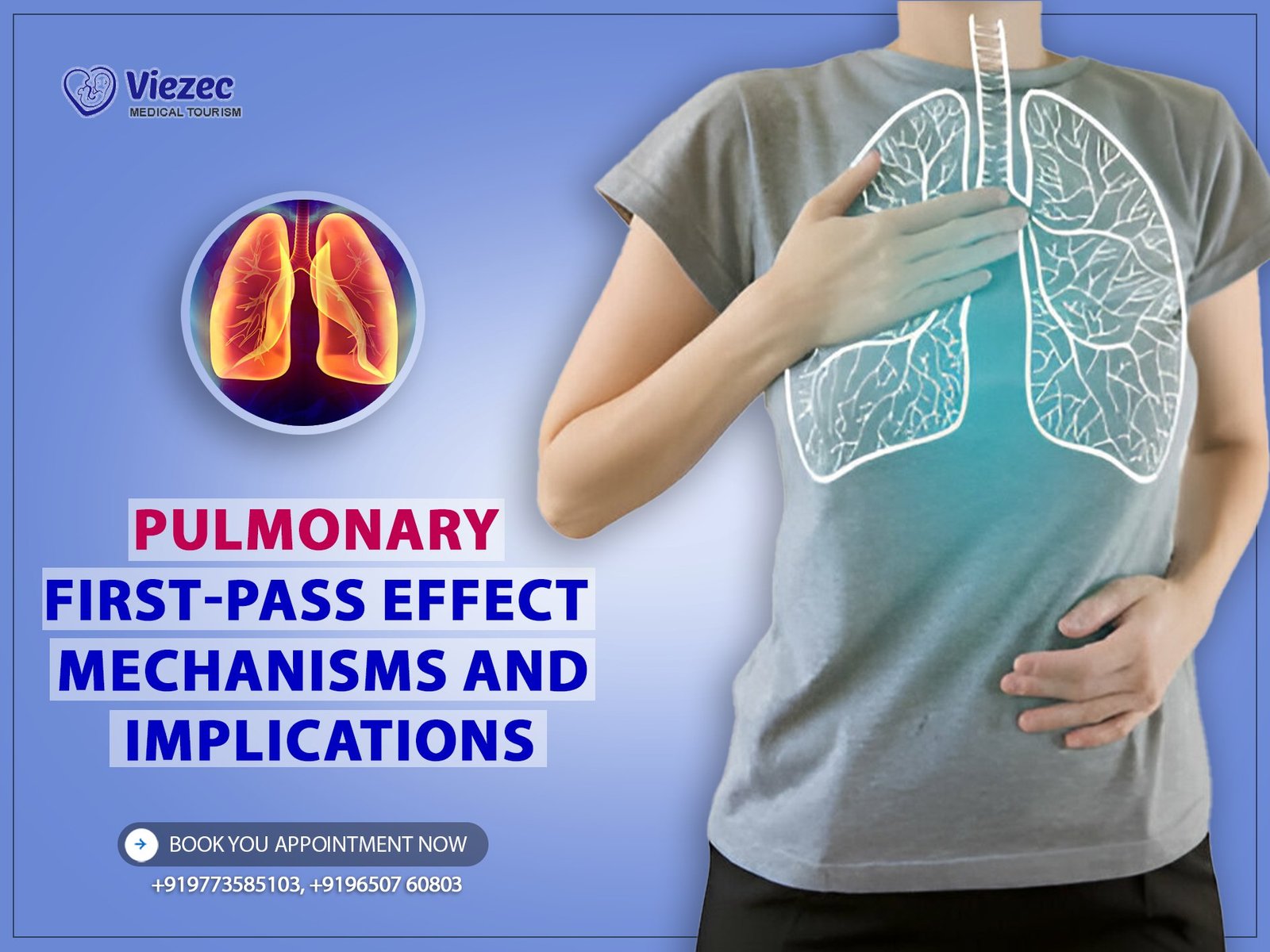The realm of drug delivery continues to evolve, with researchers delving into innovative avenues for optimizing therapeutic outcomes. Among these avenues, the pulmonary route stands out for its unique characteristics and potential advantages. Central to understanding pulmonary drug delivery is the concept of the Pulmonary First-Pass Effect, a phenomenon with profound implications for pharmacokinetics and pharmacodynamics. This article explores the mechanisms underlying this phenomenon, its significance in drug delivery, clinical implications, and future prospects.
Understanding Pulmonary First-Pass Effect
The Pulmonary First-Pass Effect refers to the rapid metabolism or degradation of a drug upon its absorption into the pulmonary circulation, before reaching systemic circulation. Unlike the hepatic first-pass effect, which primarily occurs in the liver, the pulmonary first-pass effect involves enzymatic activity within the lungs. This process can significantly affect the bioavailability and efficacy of drugs administered via inhalation, necessitating a nuanced understanding of pulmonary pharmacokinetics.
Significance of Pulmonary First-Pass Effect in Drug Delivery
The significance of the Pulmonary First-Pass Effect lies in its influence on the pharmacokinetic profile of inhaled medications. By metabolizing or degrading drugs within the lungs, the first-pass effect can alter systemic exposure, onset of action, and duration of therapeutic effects. Consequently, it plays a pivotal role in determining the efficacy and safety profiles of pulmonary therapeutics, shaping clinical outcomes and treatment strategies.
Anatomy of the Respiratory System
Alveolar Structure and Function
The alveoli, the site of gas exchange in the lungs, comprise a complex network of epithelial cells and capillaries. This anatomical arrangement facilitates efficient exchange of oxygen and carbon dioxide, while also serving as the primary site for drug absorption in pulmonary delivery systems. Understanding the structural intricacies of alveoli is essential for elucidating the mechanisms underlying pulmonary drug transport and metabolism.
Pulmonary Circulation: Blood Supply to the Lungs
The pulmonary circulation, distinct from the systemic circulation, plays a crucial role in facilitating gas exchange and delivering oxygenated blood to the body. Within this circulatory system, drugs absorbed from the alveoli enter pulmonary capillaries, where they encounter metabolizing enzymes and transporters that contribute to the first-pass effect. The intricate interplay between pulmonary anatomy and circulation influences drug disposition and bioavailability in the lungs.
Mechanisms of Pulmonary First-Pass Effect
Alveolar Epithelial Barrier: Role in Drug Absorption
The alveolar epithelium serves as a dynamic barrier for drug absorption, regulating the passage of molecules into systemic circulation. Lipophilic compounds can readily traverse this barrier via passive diffusion, whereas hydrophilic drugs may require specialized transport mechanisms. The composition and integrity of the alveolar epithelium influence the extent of drug absorption and subsequent metabolism within the lungs.
Pulmonary Metabolizing Enzymes: Impact on Drug Bioavailability
Enzymes such as cytochrome P450 (CYP) isoforms and esterases are abundantly expressed in the lungs, where they catalyze the biotransformation of exogenous compounds. By metabolizing drugs into inactive or active metabolites, these enzymes play a crucial role in determining drug concentrations reaching systemic circulation. Variability in enzyme expression and activity can contribute to inter-individual differences in pulmonary drug metabolism and response.
Transporters in the Respiratory Tract: Facilitators of First-Pass Effect
Transporter proteins localized within the respiratory tract modulate the influx and efflux of drugs, influencing their distribution and elimination kinetics. Efflux transporters such as P-glycoprotein (P-gp) actively pump drugs out of pulmonary cells, contributing to the first-pass effect by reducing intracellular drug concentrations. Conversely, influx transporters facilitate the uptake of substrates into cells, affecting drug absorption and bioavailability.
Factors Influencing Pulmonary First-Pass Effect
Physicochemical Properties of Drugs
The physicochemical properties of drugs, including molecular size, lipophilicity, and solubility, profoundly influence their absorption and metabolism in the lungs. Small, lipophilic molecules tend to diffuse across the alveolar epithelium more readily than larger, hydrophilic compounds. Additionally, the formulation of inhaled medications can impact pulmonary drug delivery, with particle size and aerosol properties affecting deposition and dissolution kinetics.
Lung Diseases and Pathophysiological Conditions
The presence of lung diseases or pathological conditions can alter the pulmonary microenvironment, affecting drug transport and metabolism. Inflammatory processes, oxidative stress, and changes in blood flow can modulate the activity of metabolizing enzymes and transporters, thereby influencing the extent of the first-pass effect. Understanding the interplay between pulmonary physiology and disease pathology is critical for optimizing drug therapy in patients with respiratory disorders.
Inhalation Route and Drug Formulation
The route of inhalation and formulation of pulmonary medications exert significant effects on drug absorption and distribution within the lungs. Nebulized solutions, dry powder inhalers, and metered-dose inhalers offer distinct advantages and challenges in terms of drug delivery efficiency and patient compliance. Formulation strategies such as particle engineering and drug encapsulation can enhance pulmonary bioavailability and minimize variability in systemic exposure.
Pharmacokinetic Considerations
Absorption Dynamics in Pulmonary First-Pass Effect
The absorption kinetics of drugs in the lungs are influenced by factors such as particle size, deposition pattern, and regional blood flow. Upon inhalation, aerosolized particles deposit in various regions of the respiratory tract, where they encounter the alveolar epithelium and undergo absorption. The rate and extent of absorption determine the onset of action and duration of therapeutic effects, reflecting the interplay between pulmonary physiology and drug properties.
Distribution and Metabolism in the Lungs
Following absorption, drugs distribute within the pulmonary parenchyma and interact with metabolizing enzymes and transporters. Metabolic biotransformation can occur rapidly, leading to the formation of metabolites with altered pharmacological activity. The distributional kinetics of drugs in the lungs are influenced by factors such as protein binding, tissue perfusion, and cellular uptake mechanisms, shaping their pharmacokinetic profile and therapeutic efficacy.
Elimination Pathways and Clearance Rates
The elimination of drugs from the lungs involves a combination of metabolic, renal, and exhalation processes. Metabolites generated within the lungs may undergo further biotransformation or be excreted via systemic circulation or mucociliary clearance. Clearance rates vary depending on the metabolic stability of drugs, the activity of pulmonary enzymes, and the presence of renal or hepatic impairment. Understanding the mechanisms of pulmonary clearance is essential for predicting drug concentrations and optimizing dosing regimens.
Clinical Implications
Impact on Drug Efficacy and Safety Profiles
The Pulmonary First-Pass Effect can profoundly impact the efficacy and safety of inhaled medications, influencing therapeutic outcomes and patient adherence. Variability in pulmonary drug metabolism and absorption kinetics can result in unpredictable systemic exposure, leading to suboptimal efficacy or increased risk of adverse effects. Clinicians must consider individual patient factors, including lung function, disease severity, and concomitant medications, when prescribing pulmonary therapeutics to optimize treatment outcomes.
Therapeutic Opportunities and Challenges
Despite the challenges posed by the Pulmonary First-Pass Effect, it also presents unique opportunities for targeted drug delivery and personalized medicine. By leveraging knowledge of pulmonary physiology and pharmacokinetics, researchers can develop novel formulations and delivery systems to enhance drug efficacy and minimize systemic side effects.
Pulmonary First-Pass Effect in Specific Drug Classes
Bronchodilators and Anti-Asthmatic Agents
Bronchodilators, such as β2-adrenergic agonists and anticholinergics, are commonly prescribed for the management of asthma and chronic obstructive pulmonary disease (COPD). While these agents primarily act locally to relieve bronchoconstriction, a fraction of the administered dose undergoes pulmonary metabolism, influencing systemic exposure and duration of action. Understanding the extent of pulmonary first-pass metabolism is crucial for dose optimization and mitigating the risk of systemic side effects.
Corticosteroids and Anti-Inflammatory Drugs
Inhaled corticosteroids (ICS) represent the cornerstone of asthma management, exerting potent anti-inflammatory effects within the airways. However, pulmonary metabolism of ICS, along with other anti-inflammatory agents such as leukotriene modifiers and mast cell stabilizers, contributes to variability in drug response and systemic exposure. Strategies to enhance pulmonary bioavailability while minimizing systemic side effects are actively pursued to improve the efficacy and safety of anti-inflammatory therapies in respiratory diseases.
Antimicrobial Agents and Antivirals
The emergence of multidrug-resistant pathogens and viral outbreaks underscores the importance of effective antimicrobial and antiviral therapies. Inhalation offers a promising route for delivering these agents directly to the site of infection, bypassing systemic metabolism and achieving high local concentrations. However, the extent of pulmonary first-pass metabolism varies among antimicrobial agents, warranting careful consideration of drug properties and formulation strategies to optimize pulmonary drug delivery and efficacy.
Emerging Trends and Future Directions
Novel Drug Delivery Systems for Pulmonary First-Pass Effect
Advances in nanotechnology and inhalation device design have paved the way for novel drug delivery systems tailored to overcome barriers associated with pulmonary first-pass metabolism. Inhalable nanoparticles, liposomes, and microparticles offer enhanced drug targeting and sustained release, minimizing systemic exposure and improving therapeutic efficacy. Integration of these innovative delivery platforms holds promise for revolutionizing pulmonary pharmacotherapy and addressing unmet clinical needs in respiratory medicine.
Precision Medicine Approaches in Pulmonary Pharmacotherapy
The era of precision medicine heralds a paradigm shift in the management of respiratory disorders, emphasizing the importance of individualized treatment strategies based on genetic, environmental, and phenotypic factors. Biomarker-driven approaches enable the identification of patients likely to benefit from specific therapies while minimizing the risk of adverse events. Incorporating pharmacogenomic data into clinical decision-making facilitates the selection of optimal drug regimens and dosing protocols, thereby maximizing therapeutic outcomes and reducing healthcare costs.
Targeted Therapies for Respiratory Disorders
The expanding repertoire of targeted therapies offers new avenues for the treatment of respiratory disorders characterized by distinct molecular pathways and pathophysiological mechanisms. Monoclonal antibodies, small molecule inhibitors, and gene therapies hold promise for addressing underlying disease mechanisms and modifying disease progression. By specifically targeting key mediators of inflammation, airway remodeling, and mucus hypersecretion, these therapies offer the potential to revolutionize the management of asthma, COPD, and other respiratory conditions, ushering in an era of personalized medicine in pulmonary pharmacotherapy.
Regulatory Considerations
FDA Guidelines on Pulmonary Drug Development
The Food and Drug Administration (FDA) provides regulatory guidance on the development and approval of pulmonary drug products, encompassing both innovative therapies and generic equivalents. Key considerations include demonstration of safety, efficacy, and quality through preclinical and clinical studies, as well as adherence to Good Manufacturing Practices (GMP) for quality assurance. Additionally, FDA encourages the use of pharmacokinetic modeling and simulation to optimize dosing regimens and predict drug behavior in diverse patient populations.
EMA Regulations and Approval Processes
The European Medicines Agency (EMA) plays a pivotal role in the evaluation and authorization of medicinal products for the European Union (EU) market. EMA guidelines outline requirements for the development, registration, and post-marketing surveillance of pulmonary drug formulations, ensuring compliance with stringent safety and efficacy standards. Collaboration between regulatory agencies facilitates harmonization of global regulatory requirements, streamlining the approval process and promoting access to innovative therapies for patients worldwide.
Harmonization Efforts for Global Standards
Harmonization initiatives led by international regulatory bodies aim to standardize regulatory requirements and facilitate mutual recognition of drug approvals across regions. The International Council for Harmonisation of Technical Requirements for Pharmaceuticals for Human Use (ICH) brings together regulatory authorities and pharmaceutical industry stakeholders to develop consensus guidelines on drug development and registration. By harmonizing technical requirements and regulatory standards, these efforts enhance efficiency, reduce duplication, and accelerate the availability of safe and effective pulmonary therapies on a global scale.
Research Challenges and Opportunities
Understanding Inter-Individual Variability
Inter-individual variability in pulmonary drug metabolism and response poses a significant challenge in clinical practice, necessitating tailored treatment approaches to optimize therapeutic outcomes. Comprehensive pharmacogenomic studies are needed to elucidate genetic determinants of drug metabolism and identify biomarkers predictive of treatment response and adverse events. Integrating pharmacogenomic data into clinical decision support systems enables personalized dosing recommendations, enhancing the precision and efficacy of pulmonary pharmacotherapy.
Long-Term Effects and Safety Monitoring
Long-term safety monitoring is essential for assessing the potential risks associated with chronic use of inhaled medications, particularly in vulnerable populations such as children, elderly individuals, and patients with comorbidities. Post-marketing surveillance studies and pharmacovigilance programs play a crucial role in detecting rare adverse events and ensuring the continued safety of pulmonary drug therapies. Furthermore, advances in real-world data analytics and digital health technologies enable proactive monitoring of treatment outcomes and adherence, empowering healthcare providers to optimize patient care and minimize risks.
Translational Research in Pulmonary Pharmacology
Translating preclinical findings into clinical practice remains a cornerstone of translational research in pulmonary pharmacology. Multidisciplinary collaborations between basic scientists, clinicians, and industry partners are essential for bridging the gap between bench and bedside, accelerating the development of novel therapies and treatment modalities.









